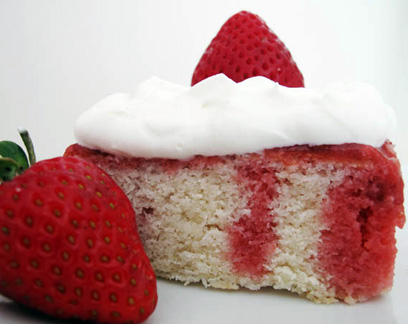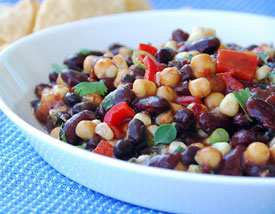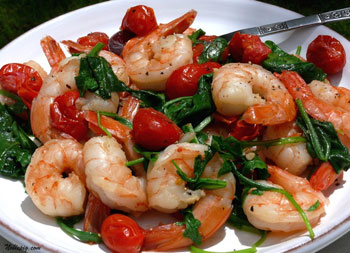 Poke Cake was created by Jell-O in 1969 to help increase sales of their product. I saw this recipe on a cooking show a couple of months ago, and they had updated the method to include real strawberries (and less Jell-O) which made the dessert more appealing to me.
Poke Cake was created by Jell-O in 1969 to help increase sales of their product. I saw this recipe on a cooking show a couple of months ago, and they had updated the method to include real strawberries (and less Jell-O) which made the dessert more appealing to me.
Although it’s great summer dessert, you can make all year round because it uses frozen strawberries. Note: The top of the cake will look slightly overbaked—this keeps the crumb from becoming too soggy after the gelatin is poured on top.

 I don't remember the first time I ate a summer cantaloupe boat, but I do know the attraction was immediate. That's surprising since it was a product of one of my mom's 1980's diets. She never did the grapefruit diet (too sour) or the cabbage soup diet (too bloating), but she did do the low-fat diet, which included rice cakes (a euphemism for styrofoam) and lots of low-cal cantaloupe.
I don't remember the first time I ate a summer cantaloupe boat, but I do know the attraction was immediate. That's surprising since it was a product of one of my mom's 1980's diets. She never did the grapefruit diet (too sour) or the cabbage soup diet (too bloating), but she did do the low-fat diet, which included rice cakes (a euphemism for styrofoam) and lots of low-cal cantaloupe. We celebrate summer with grilled meats and boiled corn, the golden ears arriving at the table, resting in silky pools of melted butter, ready for a dusting of freshly ground sea salt and black pepper.
We celebrate summer with grilled meats and boiled corn, the golden ears arriving at the table, resting in silky pools of melted butter, ready for a dusting of freshly ground sea salt and black pepper. What do potato salad, corn-on-the-cob, watermelon, and bean salad all have in common? They're requisite summer cookout foods.
What do potato salad, corn-on-the-cob, watermelon, and bean salad all have in common? They're requisite summer cookout foods. The best thing about this time of year is the abundance of fresh ingredients available at the Farmer's Markets and roadside farm stands. Freshly harvested arugula is widely available right now, which makes me almost giddy, I love it's peppery flavor.
The best thing about this time of year is the abundance of fresh ingredients available at the Farmer's Markets and roadside farm stands. Freshly harvested arugula is widely available right now, which makes me almost giddy, I love it's peppery flavor.